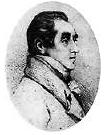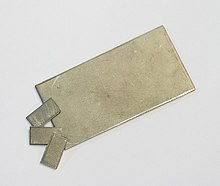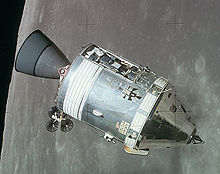User:Stone~simplewiki/niobium
Niobium (pronounced /naɪˈoʊbiəm/) (Greek mythology: Niobe, daughter of Tantalus), or columbium (/kəˈlʌmbiəm/), is a chemical element with symbol Nb and atomic number 41. A rare, soft, grey, ductile transition metal, niobium is found in the minerals pyrochlore (the main source for niobium) and columbite.
Niobium has similar physical and chemical properties to another element, tantalum, and the two are therefore difficult to distinguish. The English chemist Charles Hatchett reported a new element similar to tantalum in 1801, and named it columbium. In 1809, the English chemist William Hyde Wollaston wrongly concluded that tantalum and columbium were identical. The German chemist Heinrich Rose determined in 1846 that tantalum ores contain a second element, which he named niobium. In 1864 and 1865, a series of scientific findings clarified that niobium and columbium were the same element (as distinguished from tantalum), and for a century both names were used interchangeably. The name of the element was officially adopted as niobium in 1949.
It was not until the early 20th century that niobium was first used commercially. Brazil is the leading producer of niobium and ferroniobium, an alloy of niobium and iron. Niobium is used mostly in alloys, the largest part in special steel such as that used in gas pipelines. Although alloys contain only a maximum of 0.1%, that small percentage improves the strength of the steel. The temperature stability of niobium-containing superalloys is important for its use in jet engines and rocket engines. These superconducting alloys, also containing titanium and tin, are widely used in MRI scanners. Other applications of niobium include its use in welding, nuclear industries, electronics, optics, numismatics and jewellery. In the last two applications, niobium's low toxicity and ability to be coloured by anodisation are particular advantages.
History[change | change source]

Niobium was discovered by the English chemist Charles Hatchett in 1801.[1] He found a new element in a mineral sample that had been sent to England from Massachusetts in 1734 by a John Winthrop,[2] and named the mineral columbite and the new element columbium after Columbia, the poetical name for America.[3] The columbium discovered by Hatchett was probably a mixture of a new element with tantalum.[3]
Subsequently, there was considerable confusion[4] over the difference between columbium (niobium) and the closely-related tantalum. In 1809, the English chemist William Hyde Wollaston compared the oxides derived from both columbium—columbite, with a density 5.918 g/cm3, and tantalum—tantalite, with a density 7.935 g/cm3, and concluded that the two oxides, despite the significant difference in density, were identical; thus he kept the name tantalum.[4] This conclusion was disputed in 1846 by the German chemist Heinrich Rose, who argued that there were two different elements in the tantalite sample, and named them after children of Tantalus: niobium (from Niobe, the goddess of tears), and pelopium (from Pelops).[5][6] This confusion arose from the minimal observed differences between tantalum and niobium. Both tantalum and niobium react with chlorine and traces of oxygen, including atmospheric concentrations, with niobium forming two compounds: the white volatile niobium pentachloride (NbCl5) and the non-volatile niobium oxychloride (NbOCl3). Scientists claimed to have discovered new elements: pelopium, ilmenium and dianium,[7] which were in fact identical to niobium or mixtures of niobium and tantalum.[8]
The differences between tantalum and niobium were unequivocally demonstrated in 1864 by Christian Wilhelm Blomstrand,[8] and Henri Etienne Sainte-Claire Deville, as well as Louis J. Troost, who determined the formulas of some of the compounds in 1865[9][8] and finally by the Swiss chemist Jean Charles Galissard de Marignac,[10] in 1866, who all proved that there were only two elements. These discoveries did not stop scientists from publishing articles about ilmenium until 1871.[11] De Marignac was the first to prepare the metal in 1864, when he reduced niobium chloride by heating it in an atmosphere of hydrogen.[12]
Although de Marignac was able to produce tantalum-free niobium on a larger scale by 1866, it was not until the early 20th century that niobium was first used commercially, in incandescent lamp filaments.[9] This use quickly became obsolete through the replacement of niobium with tungsten, which has a higher melting point and thus is preferable for use in incandescent lamps. The discovery that niobium improves the strength of steel was made in the 1920s, and this remains its predominant use.[9] In 1961 the American physicist Eugene Kunzler and coworkers at Bell Labs discovered that niobium-tin continues to exhibit superconductivity in the presence of strong electric currents and magnetic fields,[13] making it the first material known to support the high currents and fields necessary for making useful high-power magnets and electrically powered machinery. This discovery would allow—two decades later—the production of long multi-strand cables that could be wound into coils to create large, powerful electromagnets for rotating machinery, particle accelerators, or particle detectors.[14][15]
Columbium (symbol Cb[16]) was the name originally given to this element by Hatchett, and this name remained in use in American journals—the last paper published by American Chemical Society with columbium in its title dates from 1953[17]—while niobium was used in Europe. To end this confusion, the name niobium was chosen for element 41 at the 15th Conference of the Union of Chemistry in Amsterdam in 1949.[18] A year later this name was officially adopted by the International Union of Pure and Applied Chemistry (IUPAC) after 100 years of controversy, despite the chronological precedence of the name Columbium.[18] The latter name is still sometimes used in US industry.[19] This was a compromise of sorts;[18] the IUPAC accepted tungsten instead of wolfram, in deference to North American usage; and niobium instead of columbium, in deference to European usage. Not everyone agreed, and while many leading chemical societies and government organizations refer to it by the official IUPAC name, many leading metallurgists, metal societies, and the United States Geological Survey still refer to the metal by the original "columbium".[20][21]
Characteristics[change | change source]
Niobium is, grey, ductile, metal. It takes on a bluish tinge when exposed to air some time.[22]
Niobium has a high melting point 2,468 °C. But a low density compared with similar metals. Acids and base are not able to disolve niobium. Due to a phenomenon called lanthanide contraction niobium and its sister metal tantalum are very similar.[23][9]
Isotopes[change | change source]
Naturally occurring niobium is composed of one stable isotope, 93Nb.[24]
As of 2003, at least 32 instable radioisotopes have also been synthesized, ranging in atomic mass from 81 to 113.[24]
Occurrence[change | change source]
Niob is a rare element. Only one of 20,000,000 atoms of the Earth’s crust is a Niobium atom.[25]
There are only three minerals which contain enough niobium for mining. These minerals always contain the sister metal tantalum.
The names of the minerals are columbite, euxenite and pyrochlore. All those minerals contain niobium togeter with other metals and oxygen[26][27]
Only brazil and canada have enough pyrochlore to produce large abounts of niobium.[9]Cite error: The opening <ref> tag is malformed or has a bad name
Production[change | change source]
The complicated step in the production of niobium is to seperate it from tantalum. Disolving in acid and forming crystalls of niobium comound is one way. Extractiong it with a solvent is another.[27][28] At the end a niobium oxide is formed. Aluminium is used to make the metal from the oxid.[29][30] Only 38,700 tonnes of niobium have been produced in 2005.[31][32]
Applications[change | change source]

Nearly all niobium is added to steel. The properties improve even on small addiotions of niobium. [33][20] This speciall steel is used in pipelines and cars.[34][35][36]


Some superalloys contain niobium. Superalloys are used in jet engines and turbines. Niobium is added to improve the properties of the superalloys. Superalloys with niobium withstand temperatures of more than 1000°C.[37] The alloys contain up to 6.5% niobium.[34]
Superconducting magnets[change | change source]
Alloys of niobium and titanium or tin become a superconductor at low temperatures.[38] With superconducting magnets strong magnetig fields are created. Those strong magnets are necessary for Magnetic resonance imaging.This method is used to look inside the body without opening it.
Coins[change | change source]
In Austria and Latvia coins made partly from niobium are minted. The colour of the niobium is not silver, but changed to blue, green, brown, purple, violet, or yellow by a electrical process.[39][40]
Precautions[change | change source]
Niobium is not toxic. Niobium metal is used in jewlery and medical implants.[41][42]
References[change | change source]
- ↑ Hatchett, Charles (1802). "Eigenschaften und chemisches Verhalten des von Charlesw Hatchett entdeckten neuen Metalls, Columbium". Annalen der Physik (in German). 11 (5): 120–122. doi:10.1002/andp.18020110507.
- ↑ Griffith, William P. (2003). "Charles Hatchett FRS (1765-1847), Chemist and Discoverer of Niobium". Notes and Records of the Royal Society of London. 57 (3): 299. doi:10.1098/rsnr.2003.0216.
{{cite journal}}: Unknown parameter|coauthors=ignored (|author=suggested) (help) - ↑ 3.0 3.1 Noyes, William Albert (1918). A Textbook of Chemistry. H. Holt & Co. p. 523.
- ↑ 4.0 4.1 Wollaston, William Hyde (1809). "On the Identity of Columbium and Tantalum". Philosophical Transactions of the Royal Society of London. 99: 246–252. doi:10.1098/rstl.1809.0017.
- ↑ Rose, Heinrich (1844). "Ueber die Zusammensetzung der Tantalite und ein im Tantalite von Baiern enthaltenes neues Metall". Annalen der Physik (in German). 139 (10): 317–341. doi:10.1002/andp.18441391006.
- ↑ Rose, Heinrich (1847). "Ueber die Säure im Columbit von Nordamérika". Annalen der Physik (in German). 146 (4): 572–577. doi:10.1002/andp.18471460410.
- ↑ Kobell, V. (1860). "Ueber eine eigenthümliche Säure, Diansäure, in der Gruppe der Tantal- und Niob- verbindungen". Journal für Praktische Chemie. 79 (1): 291–303. doi:10.1002/prac.18600790145.
- ↑ 8.0 8.1 8.2 Marignac, Blomstrand, H. Deville, L. Troost und R. Hermann (1866). "Tantalsäure, Niobsäure, (Ilmensäure) und Titansäure". Fresenius' Journal of Analytical Chemistry. 5 (1): 384–389. doi:10.1007/BF01302537.
{{cite journal}}: CS1 maint: multiple names: authors list (link) - ↑ 9.0 9.1 9.2 9.3 9.4 Gupta, C. K. (1994). Extractive Metallurgy of Niobium. CRC Press. pp. 1–16. ISBN 0849360714.
{{cite book}}: Unknown parameter|coauthors=ignored (|author=suggested) (help) - ↑ Marignac, M. C. (1866). "Recherches sur les combinaisons du niobium". Annales de chimie et de physique (in French). 4 (8): 7–75.
- ↑ Hermann, R. (1871). "Fortgesetzte Untersuchungen über die Verbindungen von Ilmenium und Niobium, sowie über die Zusammensetzung der Niobmineralien (Further research about the compounds of ilmenium and niobium, as well as the composition of niobium minerals)". Journal für Praktische Chemie (in German). 3 (1): 373–427. doi:10.1002/prac.18710030137.
- ↑ "Niobium". Universidade de Coimbra. Retrieved 2008-09-05.
- ↑ Geballe et al. (1993) gives a critical point at currents of 150 kiloamperes and magnetic fields of 8.8 tesla.
- ↑ Geballe, Theodore H. (October 1993). "Superconductivity: From Physics to Technology" (PDF). Physics Today. 46 (10): 52–56. doi:10.1063/1.881384.
- ↑ Matthias, B. T. (1954). "Superconductivity of Nb3Sn". Physical Review. 95: 1435–1435. doi:10.1103/PhysRev.95.1435.
{{cite journal}}: Unknown parameter|coauthors=ignored (|author=suggested) (help) - ↑ Kòrösy, F. (1939). "Reaction of Tantalum, Columbium and Vanadium with Iodine". Journal of the American Chemical Society. 61 (4): 838–843. doi:10.1021/ja01873a018.
- ↑ Ikenberry, Luther (1953). "Photometric Determination of Columbium, Tungsten, and Tantalum in Stainless Steels". Analytical Chemistry. 25 (9): 1340–1344. doi:10.1021/ac60081a011.
{{cite journal}}: Unknown parameter|coauthors=ignored (|author=suggested) (help) - ↑ 18.0 18.1 18.2 Rayner-Canham, Geoff (2008). "Naming elements after scientists: an account of a controversy". Foundations of Chemistry. 10 (1): 13–18. doi:10.1007/s10698-007-9042-1.
{{cite journal}}: Unknown parameter|coauthors=ignored (|author=suggested) (help) - ↑ Clarke, F. W. (1914). "Columbium Versus Niobium". Science. 39 (995): 139–140. doi:10.1126/science.39.995.139. PMID 17780662.
- ↑ 20.0 20.1 Cite error: The named reference
patelwas used but no text was provided for refs named (see the help page). - ↑ Norman N., Greenwood (2003). "Vanadium to dubnium: from confusion through clarity to complexity". Catalysis Today. 78 (1–4): 5–11. doi:10.1016/S0920-5861(02)00318-8.
- ↑ Lide, David R. (2004). "The Elements". CRC Handbook of Chemistry and Physics (85 ed.). CRC Press. pp. 4–21. ISBN 9780849304859.
- ↑ Cite error: The named reference
Nowakwas used but no text was provided for refs named (see the help page). - ↑ 24.0 24.1 Georges, Audi (2003). "The NUBASE Evaluation of Nuclear and Decay Properties". Nuclear Physics A. 729. Atomic Mass Data Center: 3–128. doi:10.1016/j.nuclphysa.2003.11.001.
- ↑ Emsley, John (2001). "Niobium". Nature's Building Blocks: An A-Z Guide to the Elements. Oxford, England, UK: Oxford University Press. pp. 283–286. ISBN 0198503407.
- ↑ Lumpkin, Gregory R. (1995). "Geochemical alteration of pyrochlore group minerals: Pyrochlore subgroup" (PDF). American Mineralogist. 80: 732–743.
{{cite journal}}: Unknown parameter|coauthor=ignored (|author=suggested) (help) - ↑ 27.0 27.1 Cite error: The named reference
ICEwas used but no text was provided for refs named (see the help page). - ↑ Cite error: The named reference
HollemanAFwas used but no text was provided for refs named (see the help page). - ↑ Tither, Geoffrey (2001). Minerals, Metals and Materials Society, Metals and Materials Society Minerals (ed.). "Progress in Niobium Markets and Technology 1981–2001". Niobium Science & Technology: Proceedings of the International Symposium Niobium 2001 (Orlando, Florida, USA). Niobium 2001 Ltd, 2002. ISBN 9780971206809.
{{cite journal}}: CS1 maint: date and year (link) CS1 maint: multiple names: editors list (link) - ↑ Dufresne, Claude (2001). Minerals, Metals and Materials Society, Metals and Materials Society Minerals (ed.). "The Production of Ferroniobium at the Niobec mine 1981–2001". Niobium Science & Technology: Proceedings of the International Symposium Niobium 2001 (Orlando, Florida, USA). Niobium 2001 Ltd, 2002. ISBN 9780971206809.
{{cite journal}}: Unknown parameter|coauthor=ignored (|author=suggested) (help)CS1 maint: date and year (link) CS1 maint: multiple names: editors list (link) - ↑ Papp, John F. "Niobium (Columbium)" (PDF). USGS 2006 Commodity Summary. Retrieved 2008-11-20.
- ↑ Papp, John F. "Niobium (Columbium)" (PDF). USGS 2007 Commodity Summary. Retrieved 2008-11-20.
- ↑ Papp, John F. "Niobium (Columbium ) and Tantalum" (PDF). USGS 2006 Minerals Yearbook. Retrieved 2008-09-03.
- ↑ 34.0 34.1 Heisterkamp, Friedrich (2001). Minerals, Metals and Materials Society, Metals and Materials Society Minerals (ed.). "Niobium: Future Possibilities – Technology and the Market Place" (PDF). Niobium Science & Technology: Proceedings of the International Symposium Niobium 2001 (Orlando, Florida, USA). Niobium 2001 Ltd, 2002. ISBN 9780971206809.
{{cite journal}}: Unknown parameter|coauthors=ignored (|author=suggested) (help)CS1 maint: date and year (link) CS1 maint: multiple names: editors list (link) - ↑ Eggert, Peter (1982). "Niobium: a steel additive with a future". Economic Bulletin. 19 (9): 8–11. doi:10.1007/BF02227064.
{{cite journal}}:|format=requires|url=(help); Unknown parameter|coauthors=ignored (|author=suggested) (help) - ↑ Hillenbrand, Hans–Georg (2001-05-02). "Development and Production of High Strength Pipeline Steels" (PDF). Niobium Science & Technology: Proceedings of the International Symposium Niobium 2001 (Orlando, Florida, USA). Europipe.
{{cite journal}}: Unknown parameter|coauthors=ignored (|author=suggested) (help) - ↑ Donachie, Matthew J. (2002). Superalloys: A Technical Guide. ASM International. pp. 29–30. ISBN 9780871707499.
- ↑ Glowacki, B. A. (2002). "Niobium based intermetallics as a source of high-current/high magnetic field superconductors". Physica C: Superconductivity. 372–376 (3): 1315–1320. doi:10.1016/S0921-4534(02)01018-3.
{{cite journal}}: Unknown parameter|coauthors=ignored (|author=suggested) (help) - ↑ "25 Euro - 150 Years Semmering Alpine Railway (2004)". Austrian Mint. Retrieved 2008-11-04.
- ↑ "Coin of Time". Bank of Latvia. Retrieved 2008-09-19.
{{cite web}}: Cite has empty unknown parameter:|1=(help) - ↑ Vilaplana, J. (1990). "New trends in the use of metals in jewellery". Contact Dermatitis. 25 (3): 145–148. doi:10.1111/j.1600-0536.1991.tb01819.x.
{{cite journal}}: Unknown parameter|coauthors=ignored (|author=suggested) (help) - ↑ Vilaplana, J. (1998). "New developments in jewellery and dental materials". Contact Dermatitis. 39 (2): 55–57. doi:10.1111/j.1600-0536.1998.tb05832.x.
{{cite journal}}: Unknown parameter|coauthors=ignored (|author=suggested) (help)
